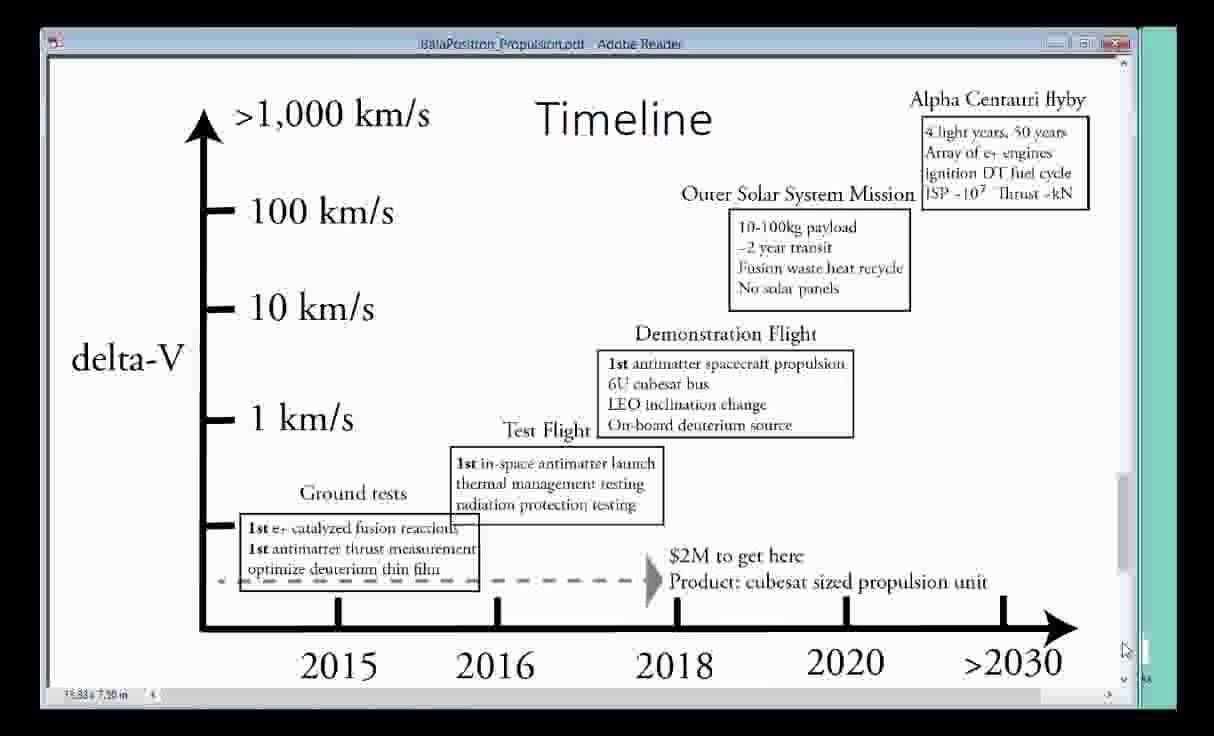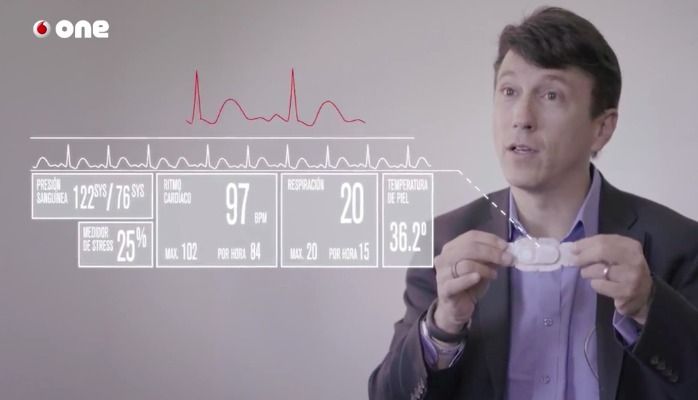Page 11643
Oct 20, 2015
Positron Dynamics plans to fly an antimatter powered cubsat
Posted by Klaus Baldauf in category: space

In 2013, Positron Dynamics had seed funding from Paypal billionaire Peter Thiel’s Breakout Labs. Initial simulations show that as much as 10 micrograms of positrons could be produced each week with a linear accelerator,” says co-founder Ryan Weed, PhD, a physicist and former cryogenic engineer for Jeff Bezos’s space flight company Blue Origin.
Now they have stated in a new presentation that they will have an antimatter powered cubesat vehicles in 2016–2019. They will be able to keep a cubesat in low earth orbit for seven years instead of few days. Then they will enable high speed spacecraft to go the outer solar system and then to the stars at a significant fraction of the speed of light.
Oct 19, 2015
SpaceX Changes Its Falcon 9 Rocket Return-to-Flight Plans — By Peter B. de Selding | SPACE.com
Posted by Odette Bohr Dienel in categories: business, Elon Musk, satellites
“SpaceX on Oct. 16 said it had changed its Falcon 9 return-to-flight plans and would first launch 11 small Orbcomm messaging satellites into low Earth orbit, and then test reignition of the rocket’s redesigned second-stage engine during the same flight before launching SES’s heavier telecommunications satellite into higher orbit, a mission that will need the reignition capability”
Tags: GEO, LEO, SpaceX, telecommunications
Oct 19, 2015
Search For Intelligent Aliens Near Bizarre Dimming Star Has Begun
Posted by Sean Brazell in category: alien life
The search for signs of life in a mysterious star system hypothesized to potentially harbor an “alien megastructure” is now underway.
Astronomers have begun using the Allen Telescope Array (ATA), a system of radio dishes about 300 miles (483 kilometers) northeast of San Francisco, to hunt for signals coming from the vicinity of KIC 8462852, a star that lies 1,500 light-years from Earth.
NASA’s Kepler space telescope found that KIC 8462852 dimmed oddly and dramatically several times over the past few years. The dimming events were far too substantial to be caused by a planet crossing the star’s face, researchers say, and other possible explanations, such as an enormous dust cloud, don’t add up, either. [13 Ways to Hunt Intelligent Alien Life].
Oct 19, 2015
Chinese Researchers Knock Out Myostatin Gene in Beagles with CRISPR, Generating First Gene-Edited Dogs
Posted by Shailesh Prasad in categories: biotech/medical, engineering, genetics
First Gene-Edited Dogs Reported in China.
An extra-muscular beagle has been created through genome engineering. Are we on our way to customizing the DNA of our pets?
Oct 19, 2015
3D printing used to make first real handheld railgun, which fires plasma projectiles at 560 mph
Posted by Sean Brazell in categories: 3D printing, engineering, military, mobile phones

If you think the image above looks frightening, you’re right. The crazy contraption pictured in the image is the first portable railgun, a futuristic projectile launcher associated most commonly with the military or NASA. The man in the image above isn’t in the military, and he’s not a NASA engineer. Instead, he’s a civilian who used some engineering smarts, some widely available parts and a 3D printer to create a functioning weapon that can fire graphite, aluminum, tungsten and even plasma projectiles at speeds of more than 560 mph.
And then there’s the best part: There are videos of this homemade railgun in action.
Oct 19, 2015
Magnetically controlled battery could store energy for power grids
Posted by Shailesh Prasad in categories: energy, innovation
(Phys.org)—Scientists have built a battery containing a magnetic fluid that can be moved in any direction by applying a magnetic field. The magnetically controlled battery concept could be especially useful for flow batteries, where it could eliminate the need for the pumps that are typically required for moving the electrolyte from an external storage tank to the inside of a power stack to provide electricity. Flow batteries are being actively researched as large-scale energy storage devices for power grids, where they could store energy captured by intermittent alternative energy sources such as wind and solar.
The researchers, led by Yi Cui, Professor at Stanford University, have published a paper on the new magnetically controlled battery in a recent issue of Nano Letters.
“The greatest significance of our work lies in the innovative idea of using a magnetic field to control and enhance the mass and electron transport in a battery system,” lead author Weiyang Li, previously at Stanford University and now at Dartmouth College, told Phys.org.
Oct 19, 2015
To infinity and beyond: Light goes infinitely fast with new on-chip material
Posted by Shailesh Prasad in categories: computing, materials, nanotechnology
Electrons are so 20th century. In the 21st century, photonic devices, which use light to transport large amounts of information quickly, will enhance or even replace the electronic devices that are ubiquitous in our lives today. But there’s a step needed before optical connections can be integrated into telecommunications systems and computers: researchers need to make it easier to manipulate light at the nanoscale.
Researchers at the Harvard John A. Paulson School of Engineering and Applied Sciences (SEAS) have done just that, designing the first on-chip metamaterial with a refractive index of zero, meaning that the phase of light can travel infinitely fast.
This new metamaterial was developed in the lab of Eric Mazur, the Balkanski Professor of Physics and Applied Physics and Area Dean for Applied Physics at SEAS, and is described in the journal Nature Photonics.
Oct 19, 2015
The tech ‘Back to the Future’ predicted for 2015 — and what it missed
Posted by Shailesh Prasad in category: futurism

How does today’s tech compare to the alternate 2015 visited by Marty McFly, and which modern marvels could never have been predicted back in the ’80s?
Oct 19, 2015
The Future of Continuous, Connected Health & Medicine: In your pocket, connected to the cloud.
Posted by Shailesh Prasad in categories: biotech/medical, health

This short video (with some fun integrated graphics) is from an interview I did with El Pais (the largest newspaper in Spain). It highlights some of the emerging technologies and approaches which have the potential to shift health, medicine and biopharma from its intermittent and reactive physician-centric mode, to an era of more continuous data and a proactive approach, in which the individual is increasingly empowered and integrated into personalized wellness, diagnosis and therapy. The video is below and some associated thoughts follow:
Diagnostics- Era of the digital black bag: Ranging from an eye, ear and throat exam (from connected devices designed for the patient like CellScope, MedWand and Tyto) to cardiac exams enabled by low cost EKG’s (AliveCor and Kito), digital diagnostics is coming to the home. Some will even do automated interpretations (i.e. the EKG interpreted by the app and send to the cloud), where the diagnosis and management of disease will increasingly be enabled outside of the usual clinic, ER or hospital. Wearable patches that integrate multiple vital signs, such as those developed by Vital Connect and Proteus Digital Health will enable more complex disease management and monitoring with ICU level data (EKG, respiratory rate, temperature, position and more), outside of the clinical environment.













